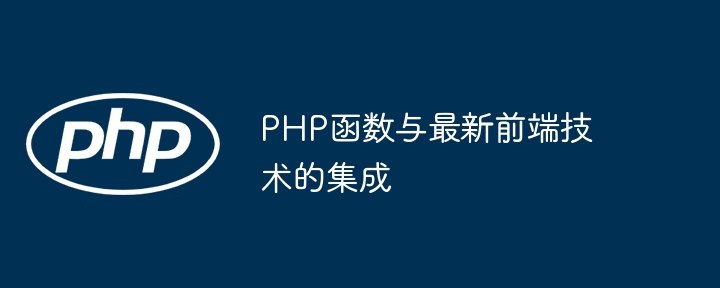 Backend Development
Backend Development
 PHP Tutorial
PHP Tutorial
 Integration of PHP functions with the latest front-end technologies
Integration of PHP functions with the latest front-end technologies
Integration of PHP functions with the latest front-end technologies
PHP functions can be integrated into front-end technology to enhance front-end functionality, including: Ajax requests: Send requests to the PHP backend, process operations and return data. WebSocket: Establish a real-time connection and continuously send data to the front end. Server-side rendering (SSR): Server-side rendering of PHP code to improve loading performance and SEO.

Integration of PHP functions with the latest front-end technology
Introduction
PHP is A server-side language widely used for back-end development. As front-end technology evolves, integrating PHP functions into modern front-end applications is becoming more and more common. This enables developers to leverage the power of PHP to enhance front-end functionality.
Methods
There are several ways to integrate PHP functions into front-end technologies:
- Ajax requests: You can use Ajax libraries such as jQuery or Axios to send requests to the PHP backend. The PHP script can then perform the relevant operations and return the response data.
- WebSocket: WebSockets allow a real-time connection to be established, so PHP functions can continuously send data to the front end, allowing for dynamic updates.
- Server Side Rendering (SSR): SSR renders PHP code to the server side and then sends the HTML to the client. This improves initial load performance and improves search engine optimization (SEO).
Practical case
Using Ajax to integrate PHP functions
// index.php
<?php
if (isset($_POST['name'])) {
$name = $_POST['name'];
echo "Hello, $name!";
}
?>// main.js
$(document).ready(function() {
$('#submit-button').click(function() {
var name = $('#name').val();
$.ajax({
type: 'POST',
url: 'index.php',
data: { name: name },
success: function(response) {
alert(response);
}
});
});
});In this example, when the user clicks When the "Submit" button is pressed, an Ajax request sends the name value to index.php. The PHP script handles the request and returns a greeting, which will be displayed in the alert dialog box.
Integrating PHP functions using WebSocket
// server.php
<?php
$server = new WebSocketServer("127.0.0.1", "8080");
$server->run();
?>// client.js
const socket = new WebSocket("ws://127.0.0.1:8080");
socket.onopen = function() {
console.log("Connected to server");
};
socket.onmessage = function(event) {
console.log("Message from server: ", event.data);
};
socket.onsend = function(event) {
console.log("Message sent to server: ", event.data);
};In this example, the WebSocket server has been established in server.php. The client uses client.js to connect to the server and can send and receive messages between the front and back ends.
The above is the detailed content of Integration of PHP functions with the latest front-end technologies. For more information, please follow other related articles on the PHP Chinese website!

Hot AI Tools

Undresser.AI Undress
AI-powered app for creating realistic nude photos

AI Clothes Remover
Online AI tool for removing clothes from photos.

Undress AI Tool
Undress images for free

Clothoff.io
AI clothes remover

AI Hentai Generator
Generate AI Hentai for free.

Hot Article

Hot Tools

Notepad++7.3.1
Easy-to-use and free code editor

SublimeText3 Chinese version
Chinese version, very easy to use

Zend Studio 13.0.1
Powerful PHP integrated development environment

Dreamweaver CS6
Visual web development tools

SublimeText3 Mac version
God-level code editing software (SublimeText3)

Hot Topics
 CakePHP Project Configuration
Sep 10, 2024 pm 05:25 PM
CakePHP Project Configuration
Sep 10, 2024 pm 05:25 PM
In this chapter, we will understand the Environment Variables, General Configuration, Database Configuration and Email Configuration in CakePHP.
 PHP 8.4 Installation and Upgrade guide for Ubuntu and Debian
Dec 24, 2024 pm 04:42 PM
PHP 8.4 Installation and Upgrade guide for Ubuntu and Debian
Dec 24, 2024 pm 04:42 PM
PHP 8.4 brings several new features, security improvements, and performance improvements with healthy amounts of feature deprecations and removals. This guide explains how to install PHP 8.4 or upgrade to PHP 8.4 on Ubuntu, Debian, or their derivati
 CakePHP Date and Time
Sep 10, 2024 pm 05:27 PM
CakePHP Date and Time
Sep 10, 2024 pm 05:27 PM
To work with date and time in cakephp4, we are going to make use of the available FrozenTime class.
 CakePHP File upload
Sep 10, 2024 pm 05:27 PM
CakePHP File upload
Sep 10, 2024 pm 05:27 PM
To work on file upload we are going to use the form helper. Here, is an example for file upload.
 CakePHP Routing
Sep 10, 2024 pm 05:25 PM
CakePHP Routing
Sep 10, 2024 pm 05:25 PM
In this chapter, we are going to learn the following topics related to routing ?
 Discuss CakePHP
Sep 10, 2024 pm 05:28 PM
Discuss CakePHP
Sep 10, 2024 pm 05:28 PM
CakePHP is an open-source framework for PHP. It is intended to make developing, deploying and maintaining applications much easier. CakePHP is based on a MVC-like architecture that is both powerful and easy to grasp. Models, Views, and Controllers gu
 CakePHP Creating Validators
Sep 10, 2024 pm 05:26 PM
CakePHP Creating Validators
Sep 10, 2024 pm 05:26 PM
Validator can be created by adding the following two lines in the controller.
 How To Set Up Visual Studio Code (VS Code) for PHP Development
Dec 20, 2024 am 11:31 AM
How To Set Up Visual Studio Code (VS Code) for PHP Development
Dec 20, 2024 am 11:31 AM
Visual Studio Code, also known as VS Code, is a free source code editor — or integrated development environment (IDE) — available for all major operating systems. With a large collection of extensions for many programming languages, VS Code can be c





